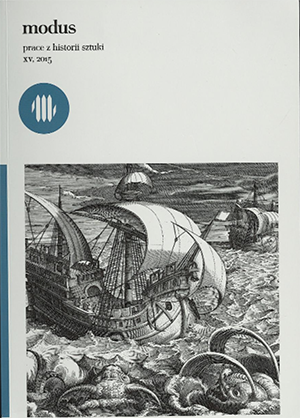Kaplica w Karniowicach w świetle ostatnich odkryć konserwatorskich
The Manorial Chapel at Karniowice in the Light of Recent Discoveries
Author(s): Elżbieta PytlarzSubject(s): History, Fine Arts / Performing Arts, Cultural history, Architecture
Published by: Instytut Historii Sztuki Uniwersytetu Jagiellońskiego
Keywords: chapel;conservation;architecture and iconography;
Summary/Abstract: The chapel in the village of Karniowice near Zabierzów was built for Jerzy Pipan, a physician from Cracow and secretary to Stanisław Lubomirski, in 1624. The freestanding structure, on an original hexagonal plan that was probably inspired by the chapels of Kalwaria Zebrzydowska, is located close to the manor house. Wall paintings, which used to cover the whole vault, entablature and most part of walls, have been discovered in the chapel during a recent conservation. The paintings were in such a poor state of preservation that not all of them could be reconstructed. Nevertheless, as a result of the conservators' efforts, the chapel can now boast an original interior decoration.The murals were painted al secco, on plaster covered with lime-paint, without the use of cartoons. Only the most detailed elements, like roses, were sketched with pencil. 1 the paintings under discussion constitute the oldest layer, which in the nineteenth century(apparently during the renovation of the chapel undertaken by one of its subsequent owners, Stanisław Mieroszowski) was covered with dark green paint. The next owner of Karniowice, who had the walls repainted again, removed the dark green coating together with the underlying a? secco decoration.The recent renovation has revealed that only natural pigments were used in the paintings which were done by two different hands. The decoration was executed before1665-1675, most likely, just after the chapel had been built, that is, in the second quarter of the seventeenth century. The paintings made the small interior of the chapel look larger and richer, because they simulated the stucco and marble architectural articulation of walls and cornice, while the dome was decorated with six mock niches with painted figures of Archangel Michael, Mary Magdalene, St Ursula and an angel. The damage to the remaining two figures is so extensive that it precludes their identification. The choice of saints suggests that the iconography of the paintings was supposed to allude to theLast judgement and Remission of Sins. The decoration, which represents typical ideas of the Counter-Reformation period, seems to be appropriate for a tomb chapel. Therefore, it cannot be excluded that the programme of the paintings was originally planned for the family chapel that jerzy Pipan had wanted to build in Cracow.The author of the paintings must have been well versed in Italian art and design, especially from the Mantua and Sabionetta area. Artistic connections with that milieu would have been possible at that time thanks to the close relationships between the families of the Myszkowskis of Pińczów and the Gonzagas of Mantua. The painter was also familiar with some Polish examples of Mannerist and early Baroque art. Decorations bearing closest resemblance to the paintings at Karniowice, yet not painted, but done in stucco, can be found in the rooms refurbished for King Sigismund III at Wawel Castle, and in theDominican and Jesuit churches in Cracow.The paintings at the chapel in Karniowice are an interesting example of Italian late Mannerist art in Poland. Certain details that were modified apparently when the work was already in process (e.g. a painted curtain as a backdrop for the altarpiece)form an axis connecting the entrance with the altar, a solution associated already with Baroque art.
Journal: Modus. Prace z historii sztuki
- Issue Year: 2015
- Issue No: 15
- Page Range: 201-216
- Page Count: 16
- Language: Polish

